Chapter 1
Probability Concepts
1.1 The given sets are:
A = {1,2,3,4} B = {0,1,2,3,4,5,6,7,8}
C = {x | x real and 1≤ x <3} D = {2,4,7} E = {4,7,8,9,10}.
We observe that:
1.2 By inspection,
A is finite and countable.
B is finite and countable.
C is infinite and uncountable.
D is finite and countable.
E is finite and countable.
(a)
BA I = A = {1,2,3,4}.
(b)
EDBA
UUU
= {1,2,3,4,5,6,7,8,9,10}.
(c)
(
DEB
U )
I
= D = {2,4,7}.
(d)
EB −
= {1,2,3,5,6}.
(e)
EDBA
III
={4}.
1.3 The universal set is U = {0,1,2,3,4,5,6,7,8,9,10,11,12}. The subsets are
A = {0,1,4,6,7,9}, B = {2,4,6,8,10,12} and C = {1,3,5,7,9,11}. By inspection,
(a)
BA I = {4,6}.
(b) (
BA U ) CI =
CA I = {1,7,9}.
1
�
2
Signal Detection and Estimation
(c)
CB U = {0}.
(d)
AB −
= {0,1,7,9}.
(e)
(
BA
U
)
(
CA
U
)
I
=
A
(
CB
I
)
U
= A = {0,1,4,6,7,9}.
(f )
CA I = {0,4,6}.
(g) −B
=C ∅.
(h)
CB I = B = {2,4,6,8,10,12}.
1.4 Applying the definitions, we have
(a)
BA −
U A
B
III )(
DCBAc
U
A B
C D
B
(b)
(
CBA
U )
I
U
A
C
Ad)(
U
A
(e) A∩B
U
A B
�
Probability Concepts
1.5 This is easily verified by Venn diagrams. Hence, we have
BA ⊂ and
CB ⊂ , then
B
A
C
B
U
B
C
CA ⊂
A
3
1.6 By inspection, B and C are mutually exclusive.
1.7 Let R, W and B denote red ball drawn, white ball drawn and blue ball drawn,
respectively
10R , 3W,
7B
(a)
=RP
(
)
(b)
=WP
(
)
balls
red of
Number
Total
of
balls
number
3
20
15.0
=
.
10
73
++
=
10
=
1
2
=
5.0
.
=
35.0
.
(c)
(e)
)
=BP
(
7
20
=WRP U
(
)
3
10
+
20
=
13
20
=
65.0
.
(d)
RP
(
1)
−=
RP
(
)
=
1
2
=
5.0
.
B1 ≡ first ball drawn is blue.
W2 ≡ 2nd ball drawn is white.
R3 ≡ 3rd ball drawn is red.
1.8 Let
and hence,
(a) The ball is replaced before the next draw ⇒ the events are independent
1
RWBP
(
I
I
2
)
3
|
3
1
1
2
2
|
)
(
)
)
=
1
RPWPBP=
(
210
8000
WBRPBWPBP
(
(
7
20
()
(
)
1
3
10
20
20
02625
.0
=
=
=
I
3
)
2
�
4
Signal Detection and Estimation
(b) Since the ball is not replaced, the sample size changes and thus, the
events are dependent. Hence,
RWBP
(
1
I
2
I
1.9
)
=
3
=
|
2
1
)
(
WBRPBWPBP
(
7
20
(
10
18
)
1
3
19
0307
.0
=
I
1
3
|
)
2
10R , 3W
B1
7B
2R , 6W
B2
1B
Let R1 and R2 denote draw a red ball from box B1 and B2 respectively, and let
W1 and W2 denote also draw a white ball from B1 and B2.
=
RRPRP
(
1
(
)
2
1
|
)
=
RPRP
(
(
)
1
2
)
since
the events are
(a)
)
2
independent. Hence,
RP
(
1
R
I
RP
(
1
=R
2
)
I
10
20
2
9
=
1
9
=
.0
111
.
(b) Similarly,
WWP
(
2
1
I
)
=
WPWP
(
2
(
)
1
)
=
3
20
6
9
=
1.0
(c) Since we can have a different color from each box separately, then
BWP
(
I
)
=
BWP
(
1
I
)
+
2
BWP
(
1
2
I
)
=
3
20
1
9
+
6
9
7
20
=
25.0
.
1.10 Let B1 and B2 denote Box 1 and 2 respectively. Let B denote drawing a black
ball and W a white ball. Then ,
B1
4W , 2B
B2
3W , 5B
�
Probability Concepts
5
Let B2 be the larger box, then P(B2) = 2P(B1). Since
BP
(
)
+
BP
(
1
2
1)
=
, we
obtain
BP
(
1
)
=
1
3
and
BP
(
2
)
=
2
3
.
(a) P(1B | B2) =
=
.0
625
.
5
8
2
6
(b) P(1B | B1) =
(c) This is the total probability of drawing a black ball. Hence
3333
.0
=
.
BP
)1(
=
=
2
BPBBP
|1(
2
5
8
3
(
1
3
)
2
6
+
=
)
2
.0
5278
.
+
BPBBP
|1(
1
(
)
1
)
(d) Similarly, the probability of drawing a white ball is
BPBWPWP
)1(
=
(
|
)
+
BPBWP
1(
1
(
)
1
|
=
1(
3
8
)
1
3
2
4
6
2
3
+
2
.0
=
4722
.
)
1.11 In four tosses:__ __ __ __, we have three 1s and one is not 1. For example
111 . Hence, the probability is
1
1
6
1
6
1
6
5
6
=
1
6
3
5
6
but we have
4
3
ways of
obtaining this. Therefore, the probability of obtaining 3 ones in 4 tosses is
!4
!1!3
1
6
3
5
6
=
.0
01543
.
1.12 Let R, W and G represent drawing a red ball, a white ball, and a green ball
respectively. Note that the probability of selecting Urn A is P(Urn A) = 0.6, Urn B
is P(Urn B) = 0.2 and Urn C is P(Urn C) = 0.2 since
P(Urn A)+P(Urn B)+P(Urn C) =1.
(a)
(P 1W | Urn B) =
WP
1(
P
Urn
I
B
)
(Urn
B
)
=
30
100
=
3.0
.
(b)
(P 1G | Urn B) =
(c) P(Urn C | R) =
P
.
40
4.0
=
100
I
RC
(Urn
RP
)
(
)
. Also,
�
6
Signal Detection and Estimation
P(R | Urn C) =
P
(Urn
P
I
RC
C
(Urn
)
)
⇒
P
(Urn
RC
|
)
=
RP
(
|
Urn
PC
)
RP
)
(
(Urn
C
)
.
We need to determine the total probability of drawing a red ball, which is
RP
(
)
=
=
Thus,
P
(Urn
Urn
)
|
(
6.0
RP
(
30
100
=RC
|
)
(Urn
(
2.0
A
)
)
+
PA
)
30
100
+
)2.0()4.0(
|
RP
(
+
40
(
2.0
100
25.0
.
=
32.0
PB
)
(Urn
B
)
+
RP
(
|
Urn
PC
)
(Urn
C
)
Urn
)
=
32.0
1.13 In drawing k balls, the probability that the sample drawn does not contain a
particular ball in the event Ei, i = 0, 1,2, … , 9, is
EP
(
)
i
=
EEP
(
i
j
)
M
9
10
=
k
8
10
k
(a) P(A) = P(neither ball 0 nor ball1) = P(E0E1) =
8
10
(b) P(B) = P( ball 1 does not appear but ball 2 does)
k
k
.
=
EP
(
1
)
−
EEP
(
1
2
)
=
k
9
10
k
−
k
8
10
k
=
9
k
k
8
−
k
10
.
−
k
7
10
k
=
8
k
k
7
−
k
10
.
(c) P(AB) =
0 EEEP
(
1
2
)
=
EEP
(
1
0
)
−
EEEP
(
1
0
(d)
BAP
(
U
)
=
AP
)
(
+
BP
(
)
−
ABP
(
)
=
k
9
1.14 We have
k
8
−
10
k
)
=
2
k
+
7
f
X
x
)(
=
−
x
e
1
2
0
−δ+
x
(
1
2
,)3
x
≥
0
,
x
<
0
k
8
10
.
k
�
Probability Concepts
7
(a)
fx(x)
1/2
(1/2)
. . x
0 1 2 3
∞
=
∫
0
)(x
x
−
e
+
1
2
xδ
(
1[
2
is a density function.
)]3
dx
−
=
∞
∫
0
1
2
−
x
e
dx
+
∞
∫
0
1
2
x
(δ
−
)3
dx
=
1
2
+
1
2
=
1
.
f
X
∞
∫
0
Hence,
dxx
)(
f X
(a) P(X = 1) = 0 (the probability at a point of a continuous function is zero).
=XP
(
)3
=
XP
(
≥
)1
=
1
2
∞
∫
1
=
5.0
.
f
X
dxx
)(
1.15
+=
1
2
∞
∫
1
1
2
−
x
e
dx
=
1
−
+
e
)
(
1
1
2
=
.0
6839
.
fX(x)
1/4
. . . . x
1/8
-3 -2 -1 0 1 2 3
(a) The cumulative distribution function of X for all the range of x is,
du
=
1
8
x
+
3
8
for
−≤≤−
3
x
1
,
x
1
∫
8
3
−
1
2
xF
)(
X
=
x
∫
∞−
f
X
duu
)(
=
x
and ∫
1
−
3
4
and
1
4
du
+
1
4
=
x
+ ∫
1
1
8
du
=
1
4
x
8
x
+
for
1
≤≤−
x
1
,
+
5
8
for
1
≤≤
x
3
,
�
8
and
xFX
1)(
=
for
Signal Detection and Estimation
x
≥
3
.
Thus,
FX (x) =
x
+
0
3
1
8
8
1
1
4
2
1
5
8
8
1
+
+
x
x
,
x
−<
3
,
1
−<≤−
3
x
,
1
<≤−
x
1
,
1
<≤
x
3
,
x
≥
3
(b) Calculating the area from the graph, we obtain
1.16 The density function is as shown
12)1
4
=

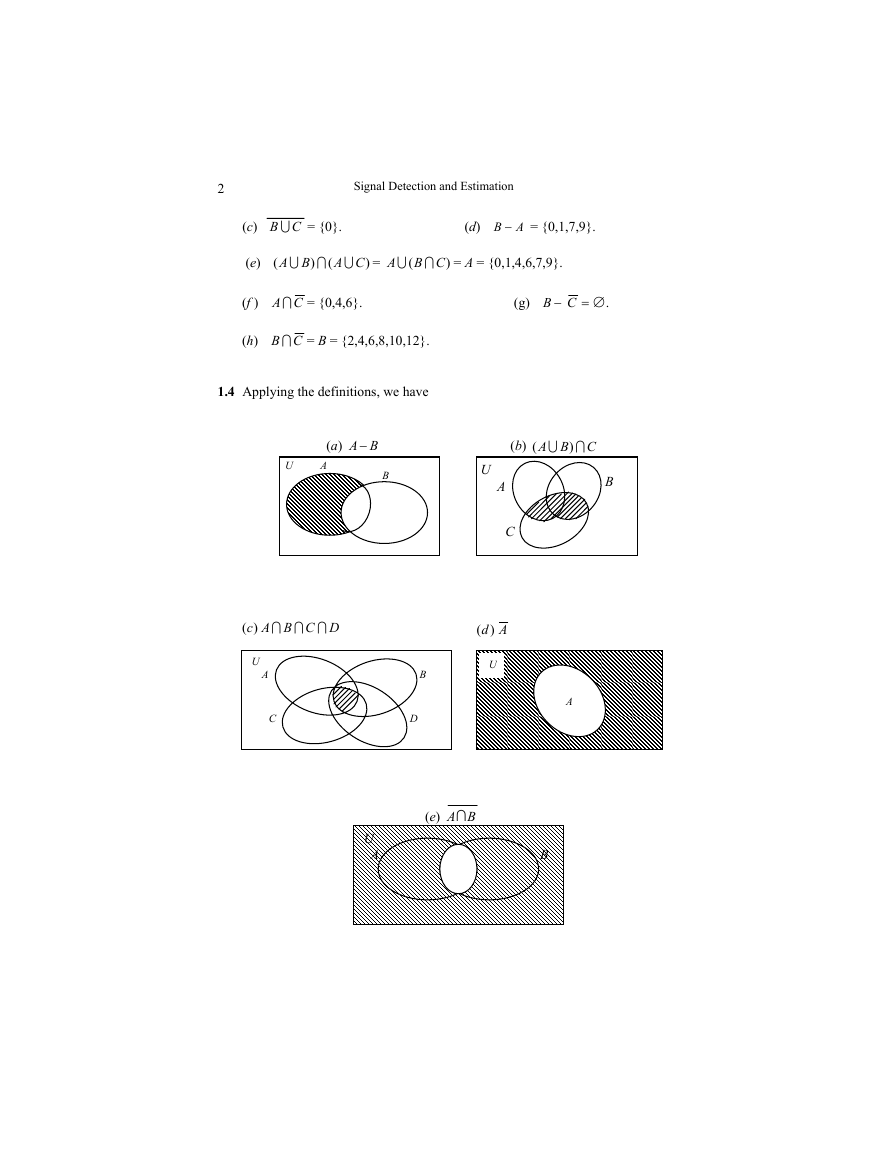
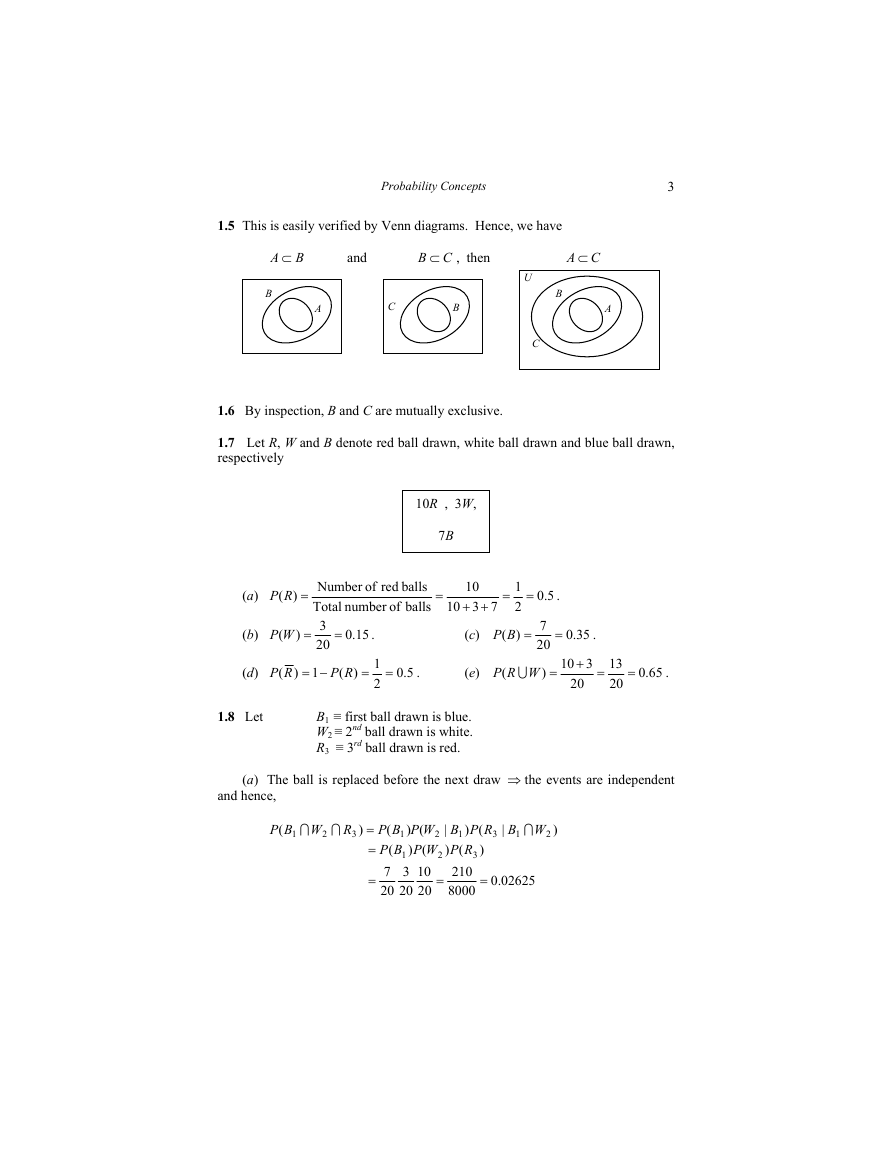
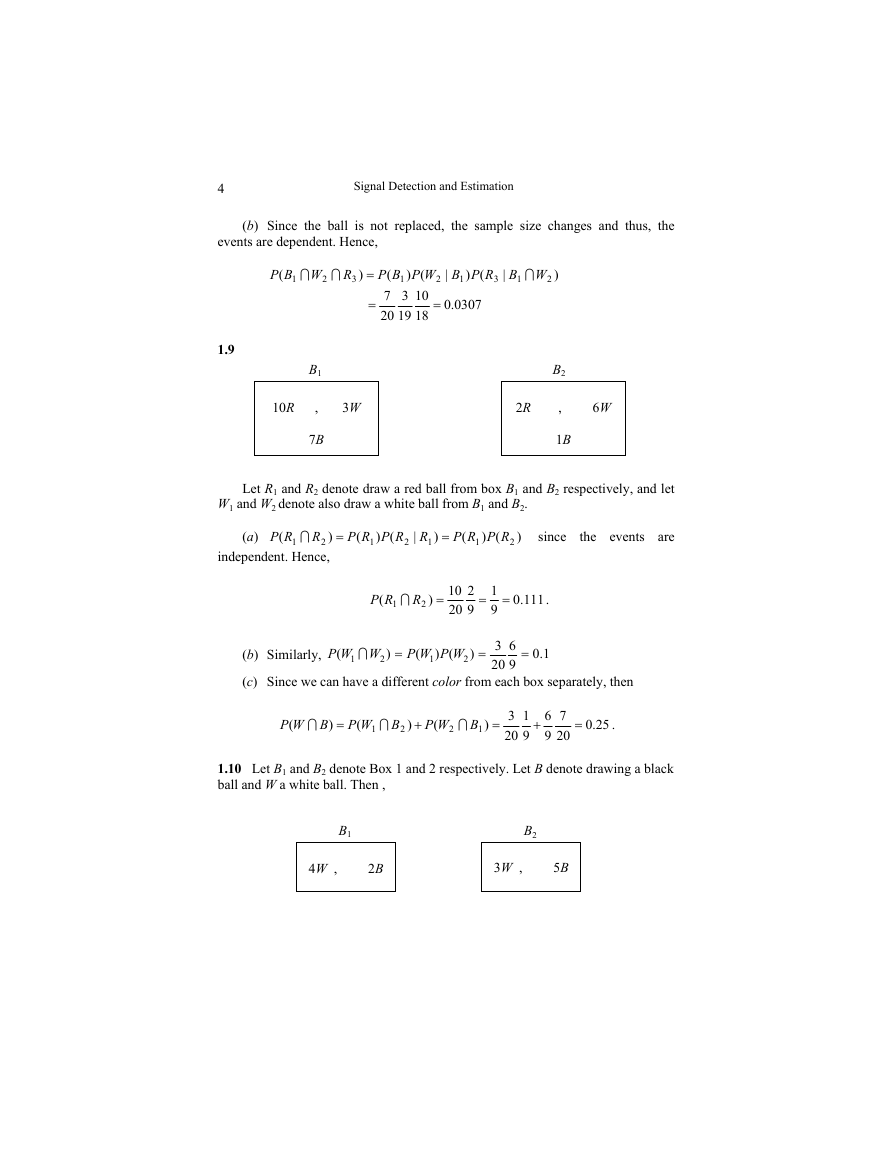


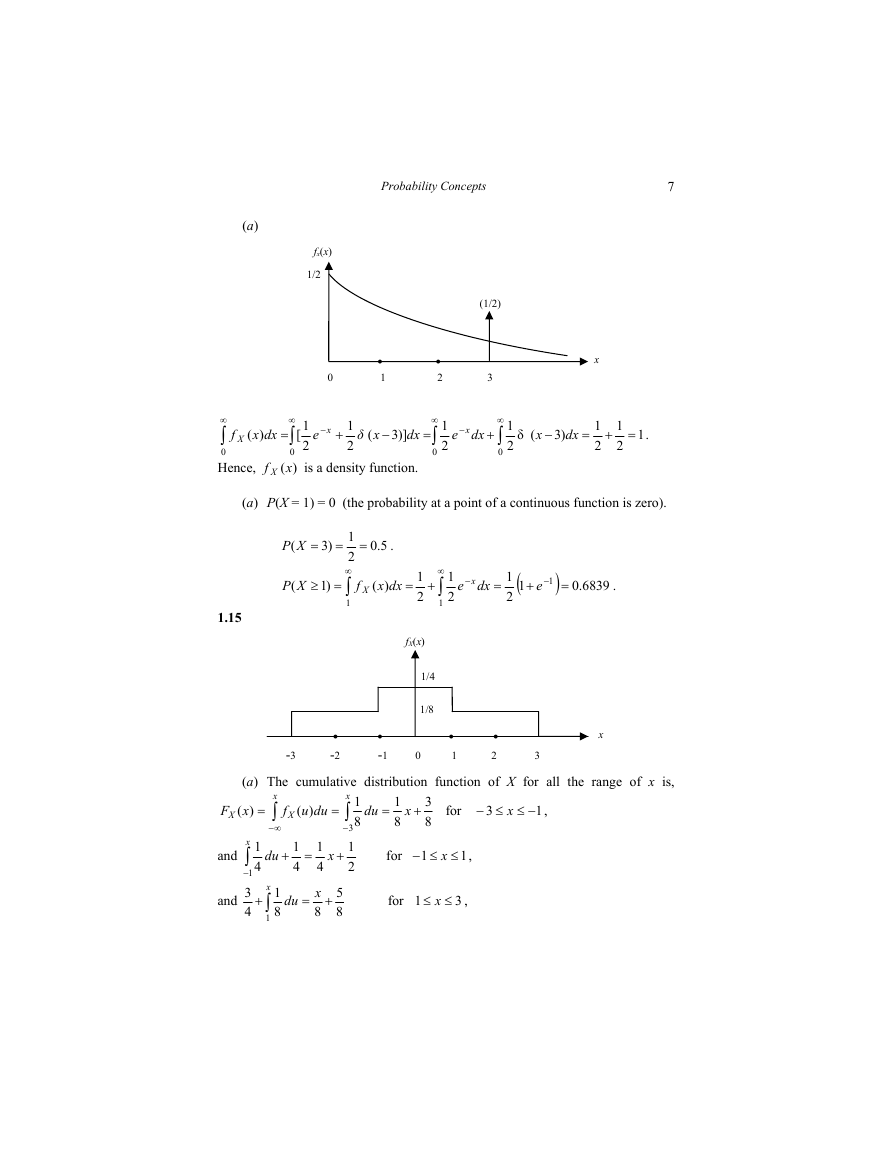
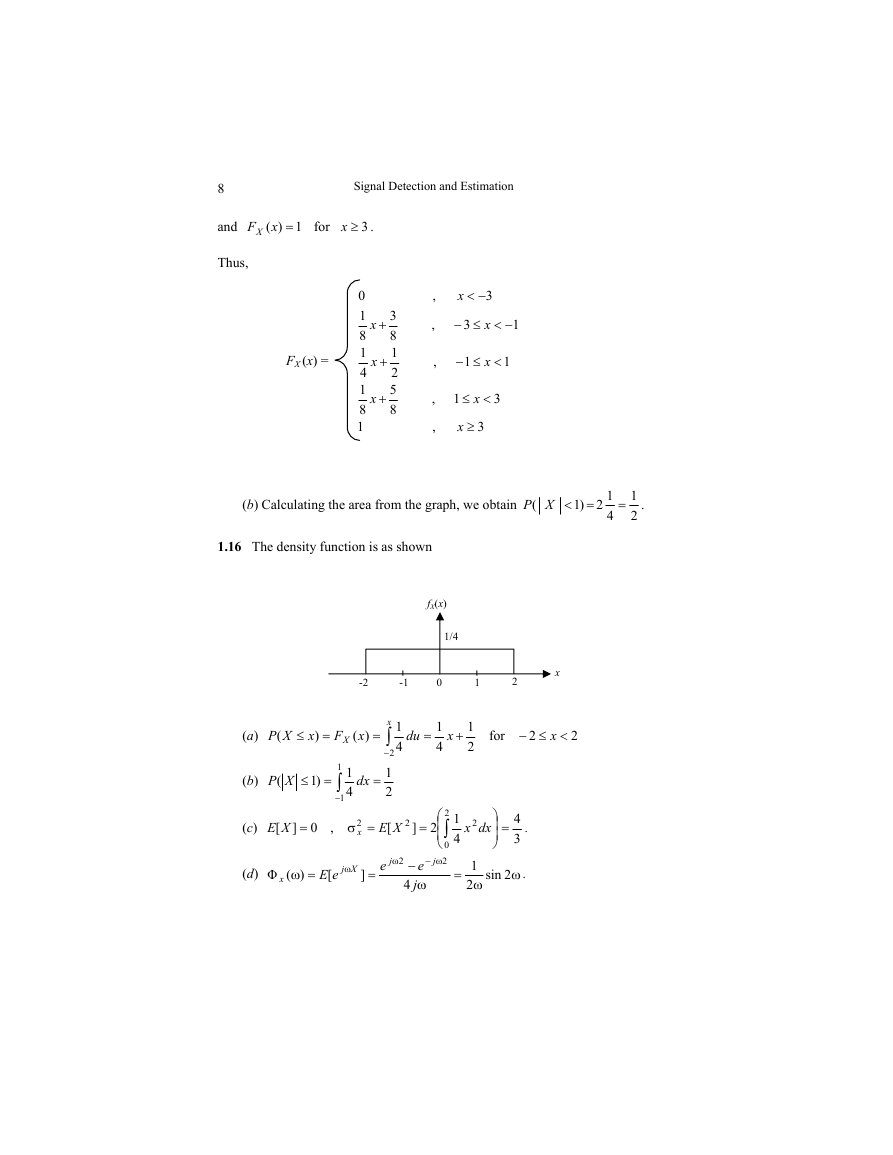








 2023年江西萍乡中考道德与法治真题及答案.doc
2023年江西萍乡中考道德与法治真题及答案.doc 2012年重庆南川中考生物真题及答案.doc
2012年重庆南川中考生物真题及答案.doc 2013年江西师范大学地理学综合及文艺理论基础考研真题.doc
2013年江西师范大学地理学综合及文艺理论基础考研真题.doc 2020年四川甘孜小升初语文真题及答案I卷.doc
2020年四川甘孜小升初语文真题及答案I卷.doc 2020年注册岩土工程师专业基础考试真题及答案.doc
2020年注册岩土工程师专业基础考试真题及答案.doc 2023-2024学年福建省厦门市九年级上学期数学月考试题及答案.doc
2023-2024学年福建省厦门市九年级上学期数学月考试题及答案.doc 2021-2022学年辽宁省沈阳市大东区九年级上学期语文期末试题及答案.doc
2021-2022学年辽宁省沈阳市大东区九年级上学期语文期末试题及答案.doc 2022-2023学年北京东城区初三第一学期物理期末试卷及答案.doc
2022-2023学年北京东城区初三第一学期物理期末试卷及答案.doc 2018上半年江西教师资格初中地理学科知识与教学能力真题及答案.doc
2018上半年江西教师资格初中地理学科知识与教学能力真题及答案.doc 2012年河北国家公务员申论考试真题及答案-省级.doc
2012年河北国家公务员申论考试真题及答案-省级.doc 2020-2021学年江苏省扬州市江都区邵樊片九年级上学期数学第一次质量检测试题及答案.doc
2020-2021学年江苏省扬州市江都区邵樊片九年级上学期数学第一次质量检测试题及答案.doc 2022下半年黑龙江教师资格证中学综合素质真题及答案.doc
2022下半年黑龙江教师资格证中学综合素质真题及答案.doc